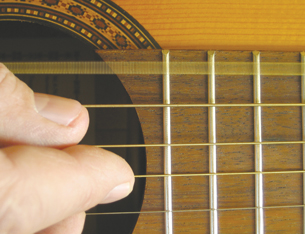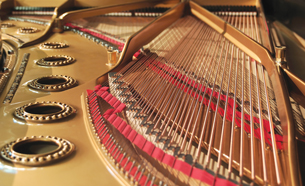Module 7—Oscillatory Motion
 Reflect and Connect
Reflect and Connect

© Zoulou 55/shutterstock
A musician plucks one string on a guitar. A note is produced and heard by a nearby audience. As long as the string is left undisturbed, it will continue to exhibit simple harmonic motion—defined by a constant period and frequency. Over time, it is perfectly reasonable to expect the string vibrations to stop, but do they ever slow down? The audience observes a constant pitch emanating from the string, but the volume of the sound drops off until, moments later, it cannot be heard. Did the frequency change, or did the amplitude change?
In order to understand this, you first need to understand the difference between volume and pitch as they relate to sound. The volume is related to the amplitude of the oscillation, which decreases over time. The pitch is related to the frequency, which does not change over time. Why?
As you have discovered, the period of a simple harmonic oscillator, such as a weighted spring, is not related to amplitude. And since frequency is the inverse of the period, it is not related either. Therefore, as the amplitude of the oscillation drops off over time, the frequency remains constant. The pitch never changes, but the volume drops off as the amplitude of each oscillation is reduced until it reaches zero.
 Discuss
Discuss

© James Steidl/shutterstock
The strings of a piano all have different masses. In the discussion forum, explain the working principles of a piano and include an explanation for all the different pitches that can be produced by a piano. Be sure to answer the following questions in your explanation.
- What difference in sound is observed when you strike the keys on the piano with different amounts of pressure?
- How can you change the pitch of any one string?
- What variable in the equation for the period of simple harmonic oscillator are you adjusting when you tune a piano string?
 Reflect on the Big Picture
Reflect on the Big Picture
Each of the Reflect on the Big Picture sections in this module will help you reinforce your learning about oscillation. Complete at least one of these reflection activities:
- Have you ever seen or driven over a washboard section of road or highway? The tires on your vehicle begin to bounce up and down as you pass over the crests and valleys of the washboard, and your tires begin to oscillate. If you are travelling too fast over a washboard section of road, you may lose control of your vehicle. How could the speed of your vehicle cause you to lose control? (Hint: Consider the time necessary for the restoring force to act.)
- Collect six pictures. Collect three pictures of things (naturally occurring or human made) that have a very high frequency, and collect three pictures of things that have a very low frequency. Each item oscillates at a frequency. Write the approximate frequency for each item on its picture.
- Name six instruments from the classical orchestra and six instruments that are used in popular music today. For each instrument, give the approximate frequency range that it can produce. If you had to play a popular song using only instruments from the classical orchestra, which instruments would you use? Explain.
Store your completed reflection in your Physics 20 course folder.
 Module 7: Lesson 1 Assignment
Module 7: Lesson 1 Assignment
Remember to submit the Module 7: Lesson 1 Assignment to your teacher.